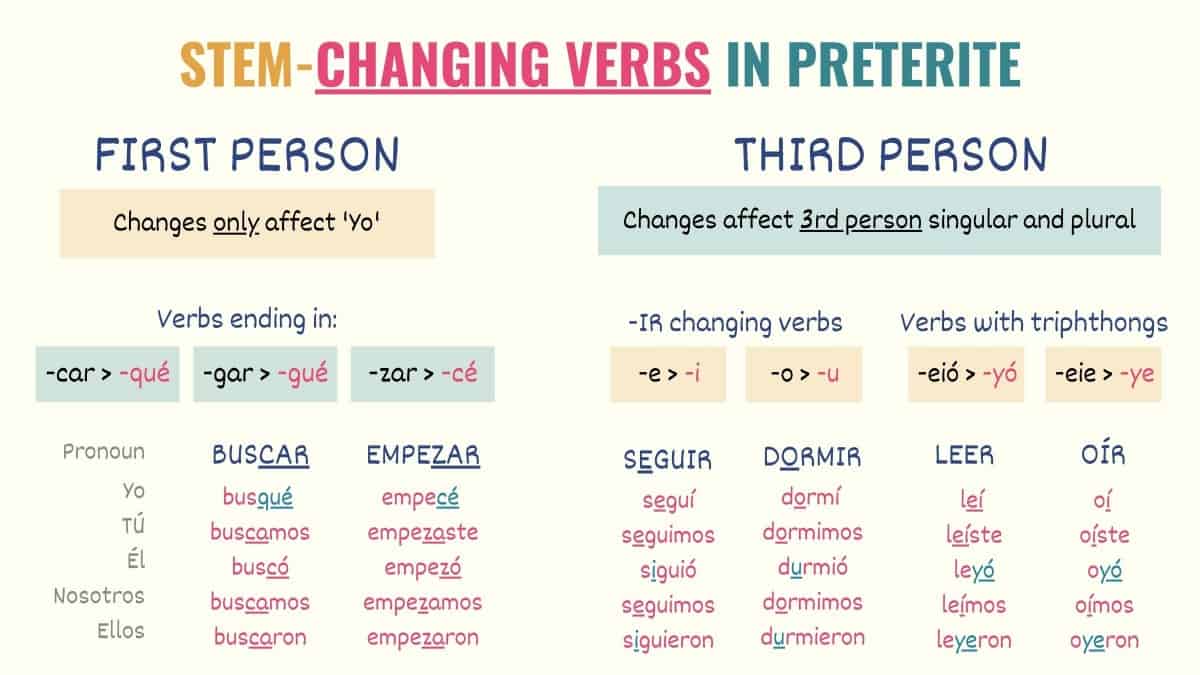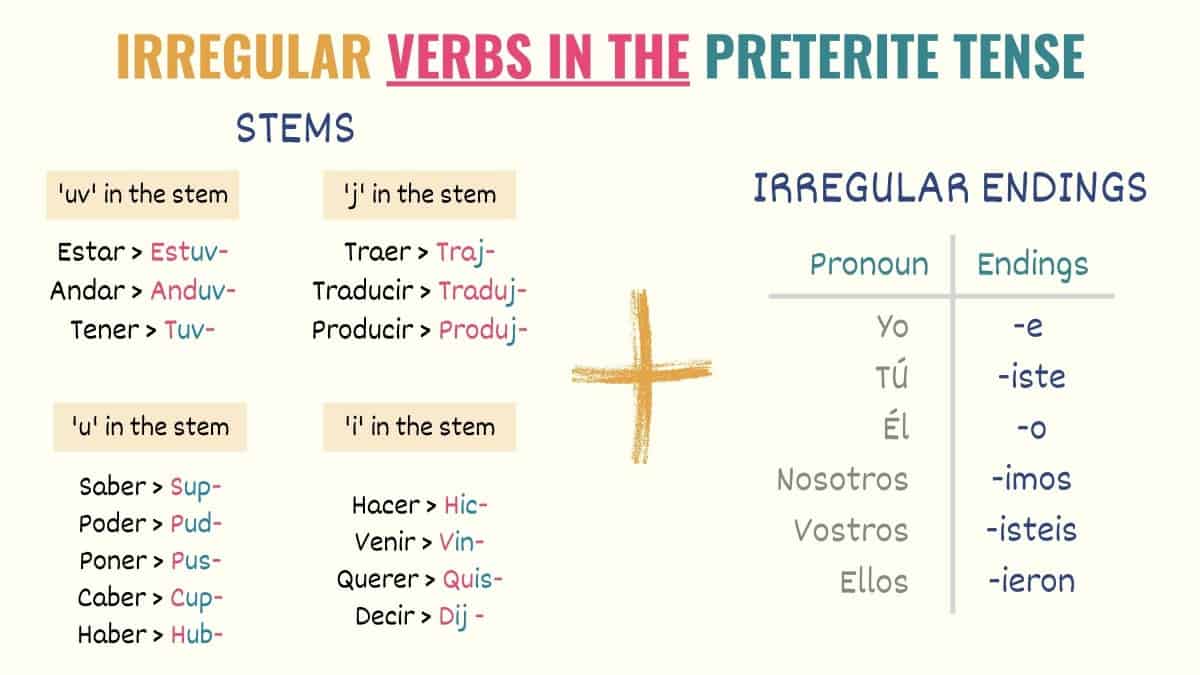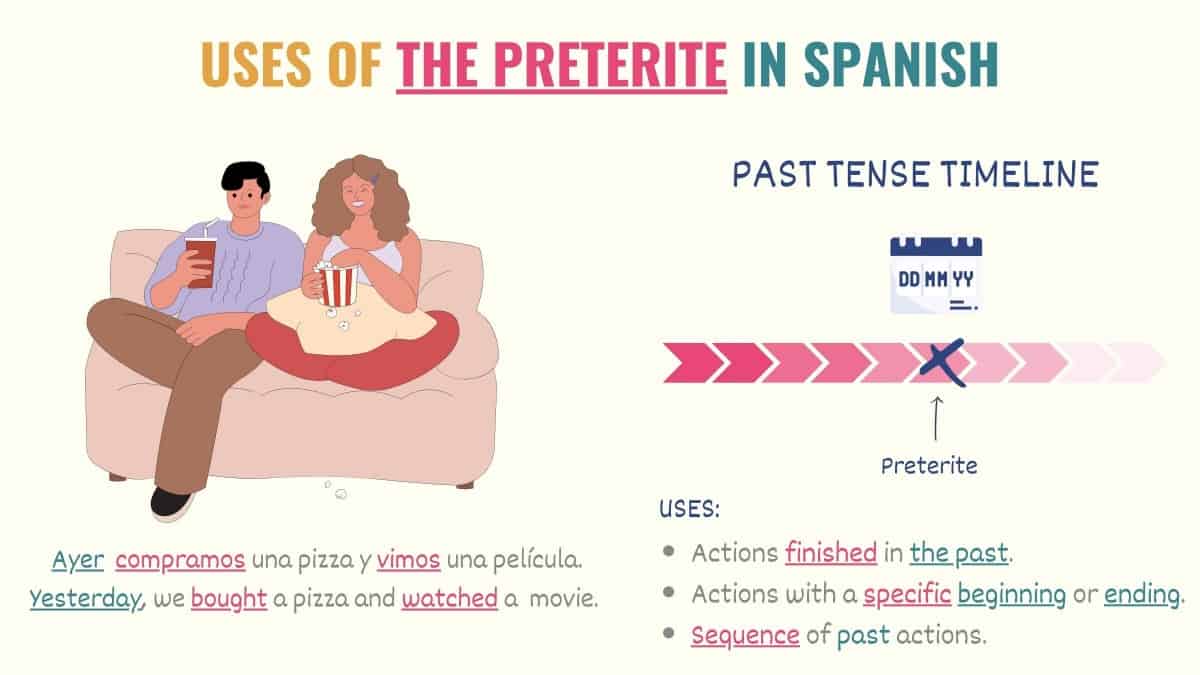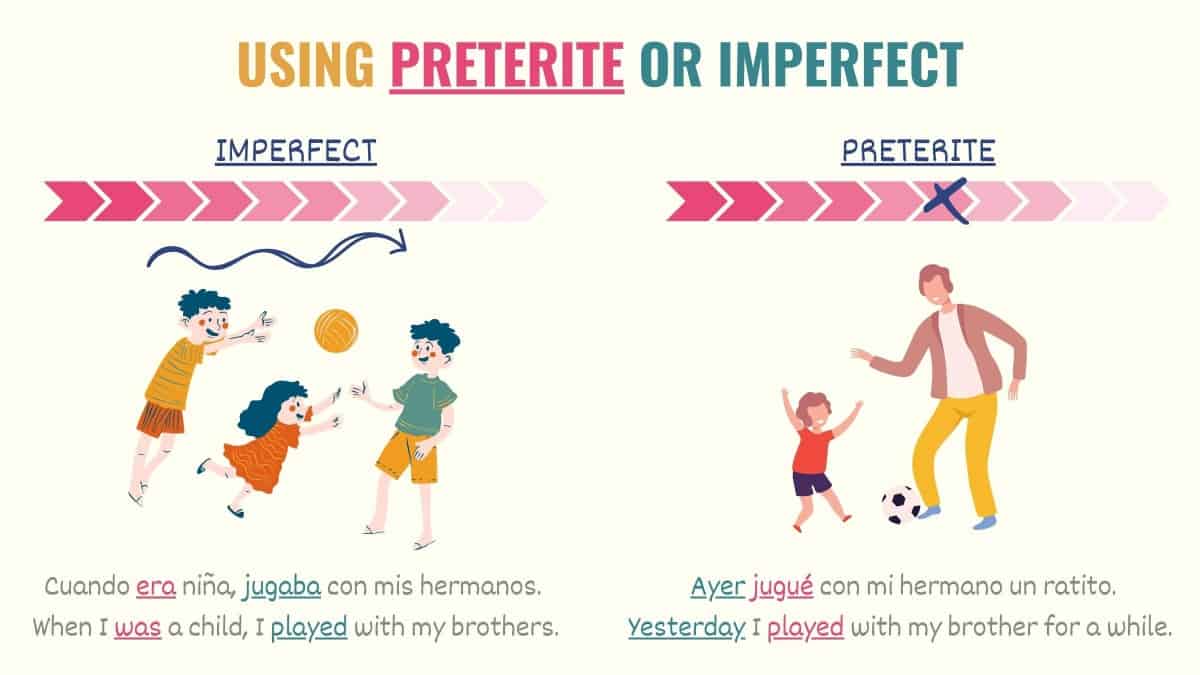

As you may already know, the present tense has many stem-changing verbs in Spanish. Verbs with spelling changes in the present tense will also have changes in the preterite tense.
Here are the verbs and the subject pronouns you need to watch out for:
You can see the changes you have to make in the graphic below:

Below are some examples with the verbs vestirse, tocar, llegar and leer.
[Verb preterite] + [complement]
Yo me v e stí y me fui.
I dressed and left.
Leah se v i stió después de bañarse.
Leah dressed after she showered.
Yo lleg ué a la una de la tarde.
I arrived at one in the afternoon.
Los chicos lle ga ron tarde.
The boys arrived late.
Ellas to ca ron la puerta.
They knocked on the door.
Yo no te to qué .
I didn’t touch you.
¿Ya l eí ste el libro?
Did you already read the book?
Oigan, ¿ya le ye ron el libro?
Hey, guys, did you already read the book?
Take Note: Accent marks are key for the Spanish preterite conjugations. In writing situations, you only need to add the proper accent mark. However, when it comes to speaking, make sure to adjust your pronunciation . Check the examples below.
Yo cant o .
I sing.
Él cant ó .
He sang.

Ser and ir are also irregular verbs. In fact, in the preterite tense, these verbs have the same conjugation. The context can help you tell which verb is being used.
| Person | Ser | Ir |
|---|---|---|
| Yo | fui | fui |
| Tú | fuiste | fuiste |
| Él / Ella / Usted | fue | fue |
| Nosotros | fuimos | fuimos |
| Vosotros | fuisteis | fuisteis |
| Ellos / Ellas / Ustedes | fueron | fueron |
Helen fue al cine .
Helen went to the movies .
Louise fue la mejor maestra que tuve.
Louise was the best teacher I ever had.
Take Note: Since they have the same conjugation, it can be hard to tell if we’re referring to ser or ir. However, unlike ‘ser’, ir is always followed by the preposition ‘a’ (to). This can be an easy and quick way to tell which verb is being used.
As a Spanish past tense, the preterite refers to past actions and events. However, this tense conveys that those actions ended or were completed at some point in the past.
We use the preterite in Spanish to talk about:

Below I’ve provided examples to clarify and illustrate each of these uses for the preterite tense in Spanish and various situations in which you can use them.
Actions completed in the past
(Subject pronoun) + [Verb in the preterite]
Hoy no desayuné.
I didn’t have breakfast today.
Charlie compró un coche nuevo.
Charlie bought a new car.
Ellos limpiaron su cuarto.
They cleaned their room.
¿Supiste que Greg y Pam se casaron?
Did you know that Greg and Pam got married?
Actions that occurred or began at a specific point in the past or lasted a specific amount of time
(Subject pronoun) + [Verb in the preterite]
Empecé a trabajar la semana pasada.
I started working last week.
Mis hermanas nacieron en abril.
My sisters were born in April.
Eleanor vivió en Barcelona durante tres años.
Eleanor lived in Barcelona for three years.
En 1950, mi abuela conoció a mi abuelo.
My grandmother met my grandfather in 1950.
Sequence of actions completed in the past
(Subject pronoun) + [Verb in the preterite] + [verb in the preterite]
Ya lavé y sequé los platos.
I already washed and dried the dishes.
Mis vecinas pintaron y remodelaron su casa.
My neighbors painted and renovated their house.
Juan se levantó, desayunó y se fue a trabajar.
Juan woke up, ate breakfast and went to work.
Take Note: In Spanish, ‘desayunar’ is a verb used to say ‘to eat breakfast’, which is why we don’t need to explicitly use ‘comer’.
Here is a table with some common time markers that work with the preterite tense:
| Spanish | English |
|---|---|
| Ya | Already |
| Ayer | Yesterday |
| El año pasado* | Last year |
| Hace* | Ago |
| Anoche | Last night |
| Hoy | Today |
| Esta mañana | This morning |
| En ese momento | In that moment |
| Una vez* | One time |
| En 1950* | In 1950 |
| La semana pasada | Last week |
| El 8 de julio* | On July 8 |
| El otro día | The other day |
Some notes about these triggering words:
Keep in mind that trigger words are a great help, but they’re not mandatory. Additionally, since Spanish is so flexible, they can be placed before or after the verb in preterite.
La semana pasada vi a Claudia.
I saw Claudia last week .
Lauren renunció hace tres años .
Lauren quit three years ago .
Hoy no fuimos a la oficina.
We didn’t go to the office today .
Take Note: Just like in English, hoy (today) can be a trigger word for the preterite tense. This is because some actions you did today are already finished. However, this use is more popular in Latin American Spanish. In Spain, you would use hoy with the present perfect tense.
The imperfect tense in Spanish is another past tense. This leads to a common question– how do you know if you have to use preterite or imperfect?
Before I give you the explanation, check the examples below.
Tip: don’t focus on the translation because it’s likely to be the same for both examples. Instead, focus on the Spanish sentences and check all the elements surrounding the verb. If you need help, jump to the graphic below.
Cuando era niña , jugaba con mis hermanos.
When I was a kid , I played with my brothers.
Ayer jugué con mi hermanito.
Yesterday I played with my little brother.
Do you see the difference?
We use imperfect tense to describe actions that we did frequently in the past. These can be habits or events that took place so often that we cannot tell the specific moment when they happened or how many times they happened.
Put another way to help you remember this rule, if we can’t perfectly point out a moment in time when the event or action took place , then it must be imperfect .
That’s the idea I’m delivering with example #1. Playing with my brothers was something I did frequently, so I cannot tell you a date or how many times we played together.
On the contrary, the preterite in Spanish is way more specific. It tells you exactly when I played with my brother and it also implies how many times I did this action…at least just for yesterday! I’m a better sister than that!
Hopefully, this graphic helps you see this distinction:

When talking about the past, the Spanish preterite refers to complete past actions. Here are some rules and key points that you need to keep in mind:
We Spanish speakers also learn the preterite in school. But, why don’t we struggle with this tense like many Spanish learners do? Because we use it all the time by speaking the language! So, to master the preterite, you need to practice a lot! You can start by taking this conjugation preterite quiz.
¡Hola! Soy Daniela Sanchez, I've been studying Spanish professionally as well as teaching it in Mexico and online for over 10 years. I’ve taught Spanish to a wide array of foreigners from many backgrounds. Over the years, I've made it my mission to work hard on refining many challenging to understand grammar topics to make my students' learning experiences easier, faster and more enjoyable. Read More About Me
Cuál vs qué is a topic that often confuses Spanish learners. Qué inquires about definitions, time, explanations, or identifies something. It’s the direct translation of ‘what’. Cuál means.
Salir vs dejar vs irse confuse learners because they all mean ‘to leave’, but aren’t interchangeable. Irse conveys and emphasizes that someone is leaving a place. Dejar expresses that someone.
¡Hola! Soy Daniela Sanchez, I've been studying Spanish professionally as well as teaching it in Mexico and online for over 10 years. I’ve taught Spanish to a wide array of foreigners from many backgrounds such as students and tourists to doctors and soldiers. Over the years, I've made it my mission to work hard on refining many challenging to understand grammar topics to make my students' learning experiences easier, faster and more enjoyable. I hope you've found what you were looking for here during your journey into Español 🙂
![]()